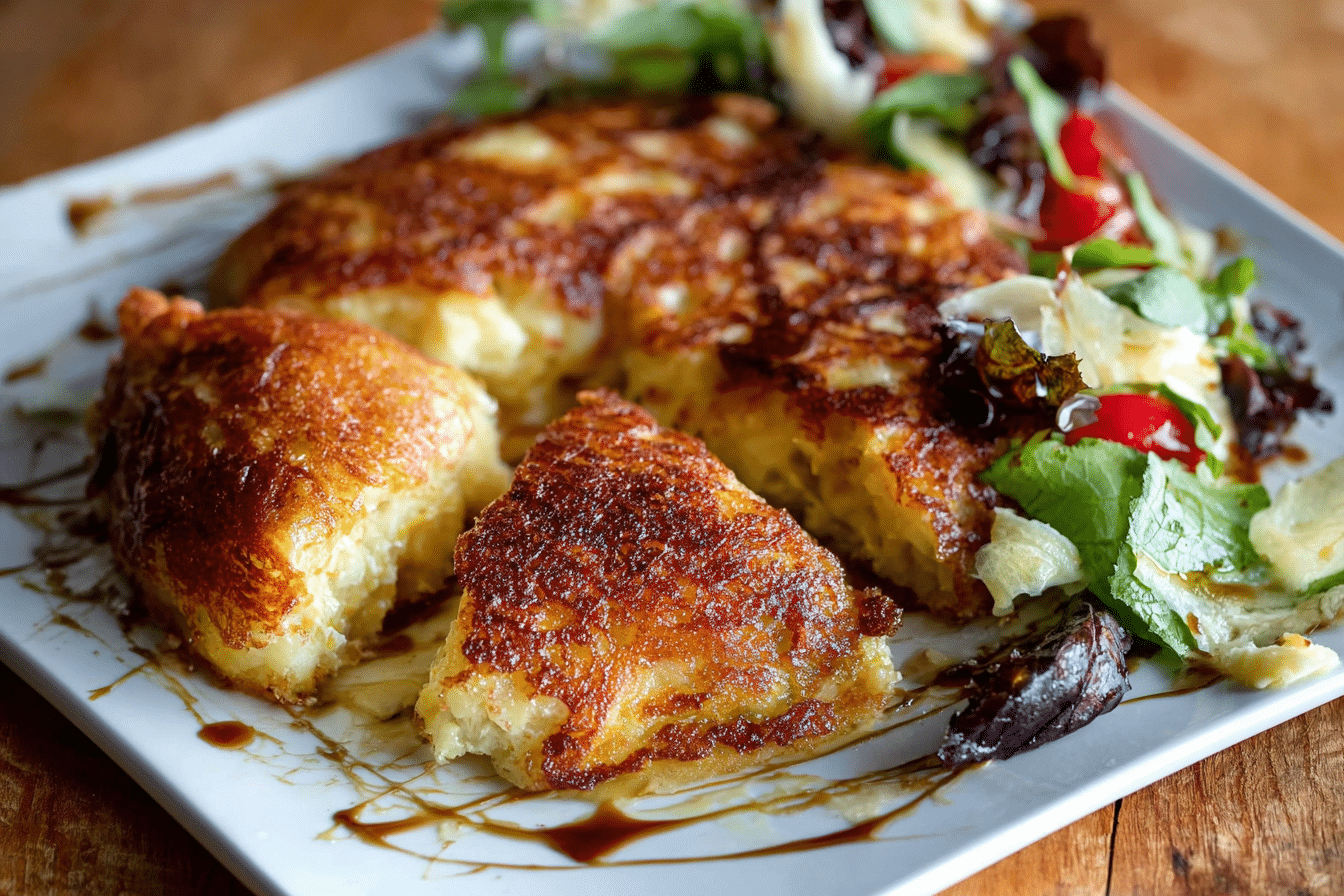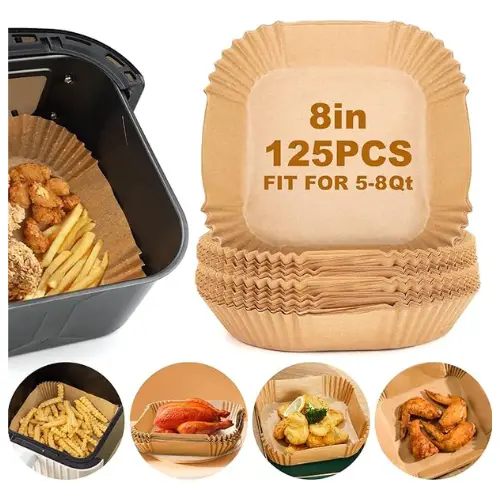Frico isn’t just a dish—it’s a golden, cheesy embrace from the mountains of Italy that’ll make you wonder where it’s been all your life. This humble masterpiece, made from crispy potatoes, caramelized onions, and melted Montasio cheese, delivers comfort in every bite. It’s the kind of meal that brings back memories you’ve never had—yet it feels deeply familiar. The magic of frico lies in its simplicity, its rustic charm, and the fact that it turns a few ingredients into something unforgettable.
Disclosure: This post contains affiliate links.If you click and make a purchase, I may earn a small commission at no extra cost to you.
Our love affair with frico started long before we added it to the recipe collection on our About Page. It all began with a journey—not just through Italian villages, but through the essence of what makes food personal. We were given a skillet of freshly prepared frico by a nonna (grandmother) during one of our first culinary excursions in Friuli-Venezia Giulia. Golden, crispy edges. Gooey center. No frills, just flavor. That bite changed everything.
It wasn’t just the food. It was the story behind it. That skillet wasn’t just seasoned with olive oil—it was seasoned with tradition, family, and the Italian way of life. From that moment on, we knew frico had to be part of Cooktune’s DNA. So, when you browse our site, you’ll find it proudly nestled in our About page story—because it reflects who we are: simple ingredients, elevated by love and heritage.
So, whether you’re a curious foodie or someone looking to add an easy showstopper to your home menu, frico is the dish you’ve been missing. It’s comforting without being boring, indulgent without being overwhelming, and just fancy enough to impress guests without a fuss.
In this deep dive, we’re giving you everything: where frico comes from, how to make it step-by-step, secret tips for perfection, creative variations, and even how to store leftovers without losing that signature crunch. By the end of this guide, you’ll not only know how to make frico—you’ll want to make it tonight.
Let’s start by uncovering the roots of this cheesy wonder.
Table of Contents
Table of Contents
What is Frico? A Golden Cheese-Potato Fusion from Friuli
So what exactly is Frico? Think of it as Italy’s answer to the ultimate comfort food. Hailing from the Friuli-Venezia Giulia region in northeastern Italy, frico is a pan-fried dish made from grated potatoes, onions, and Montasio cheese—a combo that somehow turns into crispy, gooey perfection.
The outer layer becomes beautifully browned and crunchy, while the inside remains soft and cheesy. The textures alone are a symphony: crispy edges, creamy center, and just the right amount of chew from the grated potatoes. This rustic dish was born out of necessity—it was originally a way to use up cheese rinds and leftover bits of potatoes. But like many humble recipes, it’s now treasured for its rich flavor and simplicity.
In its most traditional form, frico is cooked in a frying pan and flipped halfway through to create a perfectly golden crust on both sides. No fancy gadgets required—just a skillet, a little patience, and a love for good food.
Let’s take a closer look at how frico has changed over the years.
Traditional vs Modern Interpretations
Frico has come a long way from being just a “peasant meal.” Traditionally, it was made with scraps—whatever cheese and potato bits a household had lying around. Back then, Montasio cheese wasn’t just an ingredient—it was a necessity because of its availability in the region.
In its classic version, frico includes:
- Grated potatoes
- Sliced onions
- Montasio cheese
- Olive oil or butter
- A pinch of salt
But fast forward to today, and frico has taken on many new forms. Some cooks add meats like speck or pancetta for extra depth. Others toss in herbs like rosemary or thyme. In modern kitchens, frico is sometimes even baked or air-fried to cut down on oil, though purists might raise an eyebrow at that!
What hasn’t changed, though, is the dish’s soul. Whether you’re in a small mountain town or a modern city kitchen, frico remains a symbol of Italian ingenuity—making something amazing out of very little.
Why Montasio Cheese is Essential to Authentic Frico
If frico had a soulmate, it would be Montasio cheese. This semi-hard cheese is aged anywhere from 2 months to over a year, and its nutty, slightly sharp flavor makes it ideal for melting and browning.
Here’s why Montasio is a must:
- Melting Point: It melts slowly, giving you time to form that coveted golden crust without burning.
- Flavor Profile: Unlike mozzarella or cheddar, Montasio has a savory, buttery taste that complements potatoes without overpowering them.
- Texture: It strikes the perfect balance between creamy and stretchy when melted.
You could swap it with other cheeses in a pinch—like Asiago or Fontina—but if you want the real deal, Montasio is non-negotiable.
In Friuli, Montasio isn’t just cheese—it’s a cultural icon. It’s DOP-certified, meaning it can only be produced in certain regions under strict conditions. That authenticity is what gives frico its distinct taste.
So before we move on to the full recipe, remember: great frico begins with great ingredients—and Montasio is the king of them all.
Print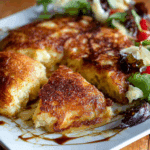
Frico in 5 Easy Steps – The Ultimate Crispy Cheese Snack
- Prep Time: 5 minutes
- Cook Time: 10 minutes
- Total Time: 15 minutes
- Yield: 4–6 Frico crisps or 1 soft Frico 1x
- Category: Appetizer / Snack
- Method: Pan-fried
- Cuisine: Italian
Description
Frico is a traditional Italian cheese crisp hailing from the Friuli-Venezia Giulia region, made primarily with Montasio cheese. Whether pan-fried into thin, lacy crisps or cooked with potatoes for a heartier version, Frico is all about that golden, cheesy crunch. It’s a snack, appetizer, or elegant garnish that brings intense umami and texture to any dish.
Ingredients
- 1 1/2 cups grated Montasio cheese (or substitute Parmesan or Asiago)
- Optional for soft Frico: 1 medium potato, peeled and thinly sliced
- 1 tbsp olive oil (if making soft Frico)
- Freshly ground black pepper (optional)
Instructions
- For crispy Frico: Heat a nonstick skillet over medium heat. Sprinkle a thin, even layer of grated cheese (about 2 tablespoons per crisp) into rounds. Cook for 3–5 minutes or until cheese is golden and lacy. Let cool briefly to firm up before removing.
- For soft Frico: Heat olive oil in a skillet over medium heat. Add potato slices and cook until tender and lightly golden. Add grated cheese evenly over the top. Press down slightly. Cook until the cheese melts and forms a crispy base and the bottom is golden brown. Carefully flip or finish under the broiler if desired.
- Season with black pepper if using. Serve hot or warm.
Notes
- Montasio cheese is traditional, but Parmigiano-Reggiano or Asiago work well too.
- To shape Frico into cups for appetizers, drape hot crisps over an inverted muffin tin or glass.
- Frico pairs beautifully with soups, salads, or as a snack on its own.
Nutrition
- Serving Size: 1 crisp or slice
- Calories: 110
- Sugar: 0g
- Sodium: 220mg
- Fat: 9g
- Saturated Fat: 6g
- Unsaturated Fat: 3g
- Trans Fat: 0g
- Carbohydrates: 1g
- Fiber: 0g
- Protein: 7g
- Cholesterol: 20mg
Ingredients Breakdown: Simplicity Meets Indulgence
Let’s be honest—Frico isn’t built on complexity. It’s built on balance. That’s the beauty of it. With just a few simple ingredients, this golden Italian treasure transforms into a deeply flavorful, crisp-edged skillet dish that somehow tastes far more complex than it looks.
You don’t need anything fancy to make this authentic dish. But you do need to understand the role of each ingredient. When used properly, they work together like an orchestra—each adding depth, texture, or richness to the final bite.
Here’s what makes this dish sing:
Selecting the Right Potatoes for the Perfect Texture
The foundation of any great frico is, without a doubt, the potato. But not just any kind will do.
For the crispiest, creamiest result, you want to use starchy red potatoes. These contain enough natural starch to bind the mixture without getting gummy, while still offering that creamy inside that contrasts beautifully with the crispy exterior.
Why red potatoes?
- They hold their shape better than Yukon golds or Russets when grated.
- Their moisture level is just right—not too dry, not too wet.
- Their skin is thin, which means less peeling or wasted product.
Tip: Always use a box grater to grate the potatoes by hand. Pre-shredded versions just don’t have the same magic—they’re often too dry and don’t crisp up well.
Once grated, press the potatoes gently between paper towels to remove excess moisture. This is the key to getting that golden, pan-fried crunch that frico is famous for.
Montasio Cheese: Taste, Texture, and Melting Properties
We already made a case for Montasio cheese in the previous section, but it deserves even more love here.
For frico, aged Montasio (2-5 months) is ideal. It melts easily, but it also holds its structure long enough to help create that coveted crust on the edges. Plus, it gives off these amazing little crispy cheese bites throughout the frico that are absolute flavor bombs.
Here’s what makes Montasio shine:
- It browns, not burns: The fat and protein content allows it to crisp perfectly in a skillet.
- It blends with the potatoes: Unlike sharper cheeses, Montasio melts gently and lets the potato flavor shine.
- It smells divine: As it cooks, it releases a nutty, slightly tangy aroma that will make you want to eat it straight out of the pan.
Pro tip: Cube the cheese into small, bite-sized pieces instead of grating it. This helps maintain small pockets of melted cheese throughout the dish—pure indulgence in every forkful.
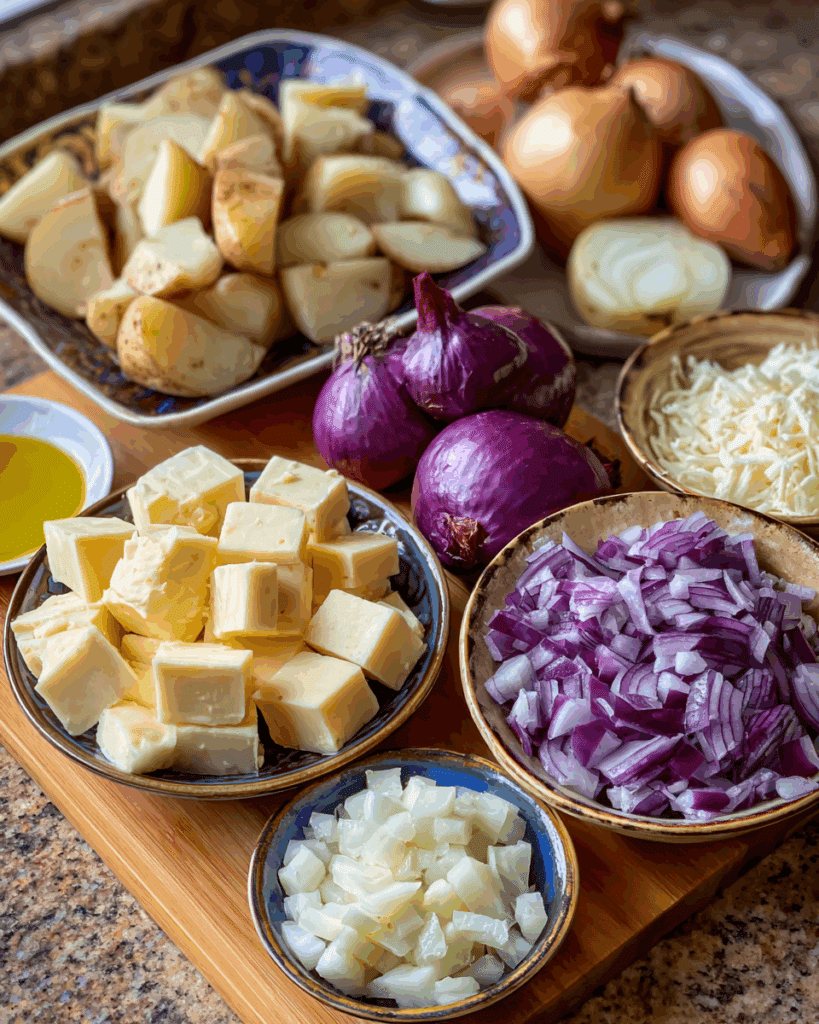
The Role of Onions, Butter, and Olive Oil in Elevating Flavor
Let’s talk aromatics and fats. Without these three heroes—onions, butter, and olive oil—your frico might fall flat.
Onions: The Unsung Hero
Use one finely sliced white or brown onion. Cook it low and slow until it becomes soft and translucent. This adds sweetness and a gentle caramelized note that enhances the richness of the cheese.
Never skip the onion. It’s not just a filler—it gives the frico that umami depth you didn’t know it needed.
Butter: For Richness and Browning
Butter isn’t just for flavor—it’s for color. That deep golden hue on your frico? Thank butter for that. It helps the exterior brown evenly and contributes a creamy undertone that ties all the elements together.
Use unsalted butter so you can control the seasoning yourself. One tablespoon is enough to coat the pan and give you that crisp foundation.
Olive Oil: For Even Cooking and a Hint of Earthiness
Olive oil adds balance. While butter gives richness, olive oil ensures the onions and potatoes cook evenly without burning. It also lends a subtle earthy flavor that rounds out the dish beautifully.
A 1:1 mix of butter and olive oil is the secret weapon for cooking frico to perfection.
Salt: The Simple Finisher
You might not think much about salt, but it plays a key role. A good pinch of salt enhances the potato’s natural flavor and brings out the best in the cheese.
Go light on the salt at first—you can always add more after tasting. Montasio is already salty enough to season most of the dish.
Try our Cheesy Saucy Lasagna for layer upon layer of cheesy indulgence.
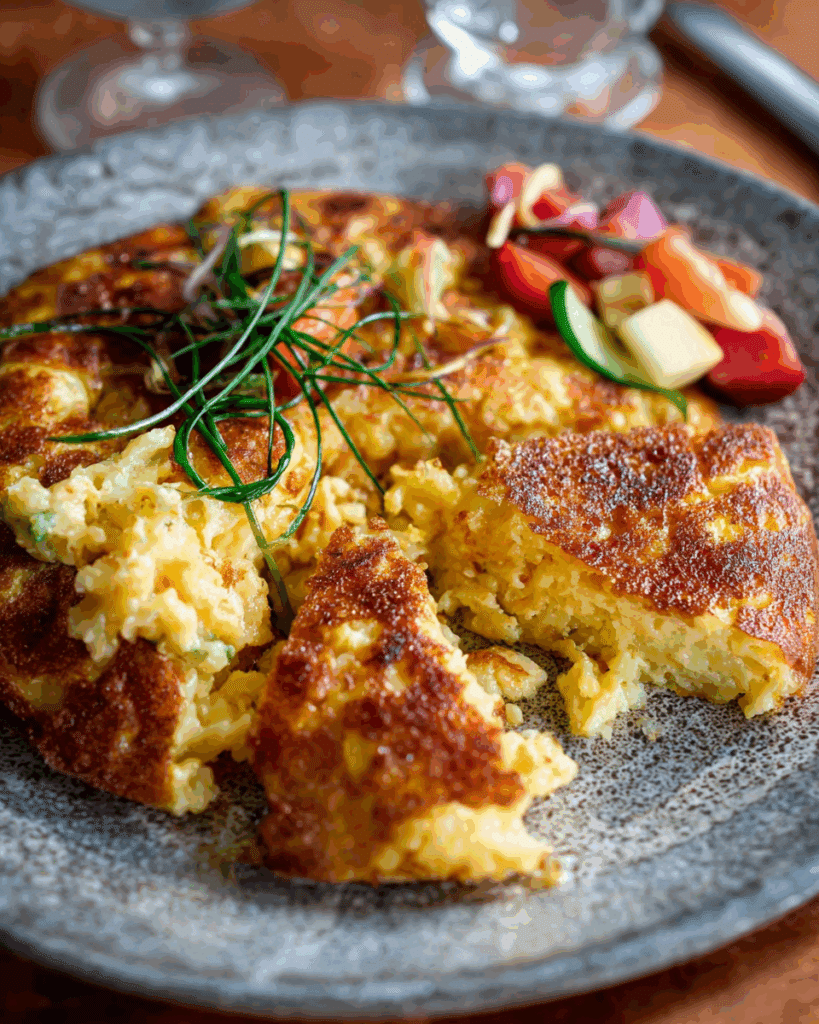
Step-by-Step Frico Cooking Instructions for Beginners
Now that you’ve gathered all your ingredients, it’s time to turn your kitchen into a little slice of Friuli-Venezia Giulia. Don’t worry if you’ve never made a dish like this before—frico is surprisingly beginner-friendly. All it takes is some prep, a nonstick pan, and a bit of patience.
Here’s your no-fail guide to making authentic frico at home.
Prepping the Potatoes and Onions Like a Pro
Let’s start with the base: your onions and potatoes.
-
Finely slice 1 brown or white onion.
Use a sharp knife to get paper-thin slices. This helps them cook down faster and blend seamlessly into the potatoes. -
Peel and grate 640g (1.5 lbs) of red potatoes.
Use the coarse side of a box grater to get nice shreds—not too fine, not too thick. Once grated, squeeze out excess moisture using paper towels or a clean kitchen cloth. Too much water will prevent crisping.
Pro Tip: Toss the grated potatoes lightly with a small pinch of salt before cooking to help release moisture early and flavor them from the inside out.
-
Cube 250g (8.8 oz) of Montasio cheese.
Avoid grating it. Cubes melt slower, creating delightful pockets of gooey cheese throughout the frico.
Now you’re prepped and ready to sizzle.
The Secret to Getting the Perfect Golden Brown Crust
This step is where the magic begins. You’ll need:
- A nonstick skillet or cast-iron pan
- 1 tbsp butter + 1 tbsp olive oil
- A spatula (preferably silicone or wooden)
Step-by-Step Cooking Method:
-
Heat the skillet over medium heat.
Melt the butter and olive oil together. Swirl to coat the pan evenly. -
Add the sliced onions.
Sauté them slowly until they’re soft, translucent, and just starting to brown—about 10 minutes. Stir occasionally so they don’t burn. -
Add the grated potatoes.
Toss the potatoes into the pan with the onions and a generous pinch of salt. Stir well to combine everything. Cook for 15 minutes, turning and tossing the mixture every 2–3 minutes with a wooden spoon or spatula.
Frico Tossing Trick: Think of it like mixing a salad—scoop under the bottom and flip up gently. This keeps the heat even and prevents sticking.
-
Add the cubed Montasio cheese.
Stir it into the hot potato-onion mixture. As the cheese melts, it will begin binding everything together. Keep stirring for about 2 minutes. -
Spread the mixture evenly.
Now flatten the frico out across the entire skillet into a circular shape about ½-inch thick. Use the spatula to press the surface down gently and tuck in any stray edges. -
Let it sit and sizzle for 6–7 minutes.
Don’t touch it. Let the bottom develop that golden brown, crispy crust. Peek by gently lifting an edge with your spatula. If it’s not brown yet, give it another minute.
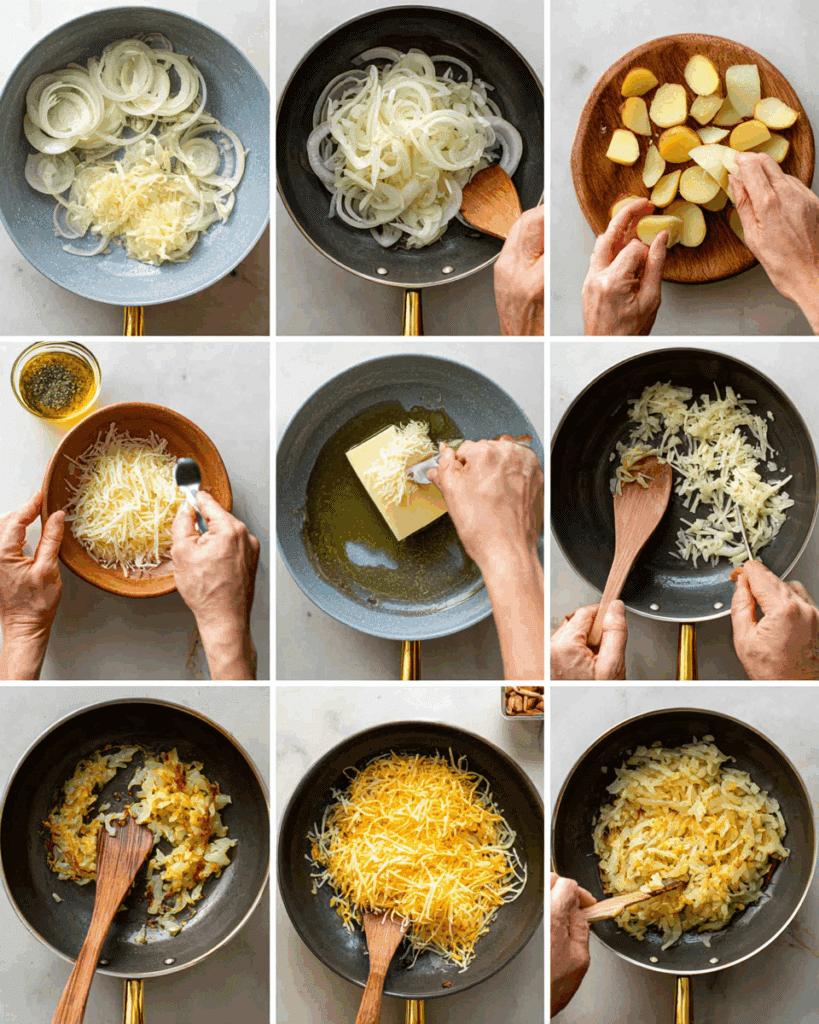
Flipping Technique: How to Cook Both Sides Without Breaking It
Here’s where most people panic—but trust me, you’ve got this.
The safest way to flip frico:
- Slide the frico onto a large plate.
- Invert the skillet upside down on top of the plate.
- Hold both the plate and skillet tightly, and flip in one quick motion.
- Return the skillet to the burner with the frico inside, now browned-side up.
It sounds dramatic, but it’s incredibly effective. Plus, it feels like a true chef moment!
Let it cook for another 6 minutes on the second side until golden brown and crisp.
When done, slide your frico onto a serving plate or wooden board. The smell alone will tempt you to dig in right away—but give it a minute or two to set so it slices cleanly.
Final Touches
- Slice like a pie and serve hot.
- You can garnish with chopped fresh herbs (optional).
- Pair it with a crisp green salad or a light white wine for the full Italian experience.
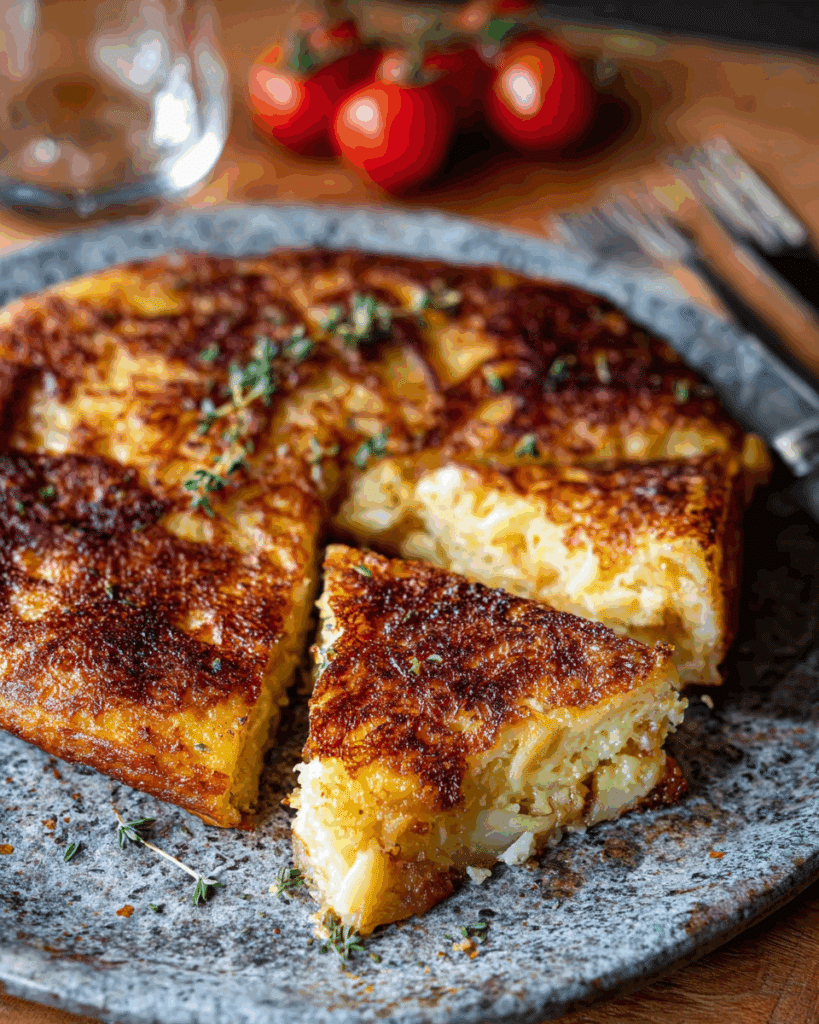
Conclusion: Frico – A Timeless Recipe That Feeds the Soul
May not be a household name around the world, but it should be. It’s the perfect representation of what Italian cooking is all about—simple ingredients, treated with respect, turned into something unforgettable.
From its humble origins in the mountains of Friuli to your modern kitchen, frico continues to bring comfort, flavor, and joy. It’s easy to prepare, endlessly adaptable, and always satisfying.
Whether you’re cooking for family, impressing guests, or just treating yourself after a long day, frico is that one-skillet wonder that makes life feel just a little more delicious.
So go ahead—grate those potatoes, cube that cheese, and bring a piece of Italy into your home tonight.
Discover how to make a Spanish Tortilla with a perfectly crisp top and melty middle.
FAQs About Frico (People Also Ask)
What does it taste like?
Frico tastes like crispy, buttery hash browns married to gooey grilled cheese. It’s savory, rich, slightly sweet from onions, and delightfully crunchy on the edges.
Can you make Frico ahead of time?
Absolutely. You can make it earlier in the day and reheat it in a pan or oven. Avoid microwaving—it kills the crisp!
Is Frico healthy or high in calories?
It’s indulgent but balanced—high in fat and carbs, but also packed with protein and nutrients from real ingredients.
What’s the best cheese substitute for Montasio?
Try Asiago, Fontina, or even mild Gruyère. Look for semi-hard cheeses that melt well but still crisp on the pan.
Is Frico kid-friendly?
Yes! Kids love the crispy texture and cheesy center. You can even shape them into fun, smaller portions for tiny hands.
Can Frico be baked instead of pan-fried?
Yes, although it’s non-traditional. Baking works best in a well-oiled cast-iron skillet in a 400°F (200°C) oven until crispy on both sides.

